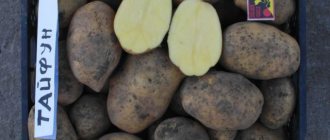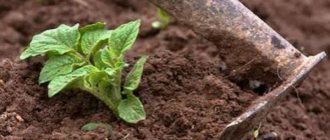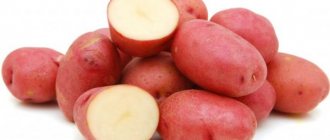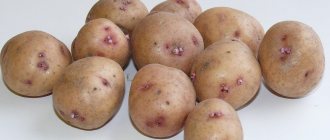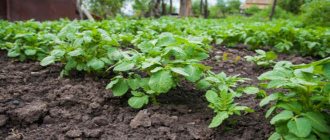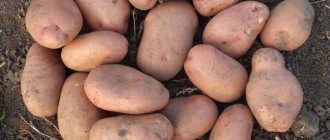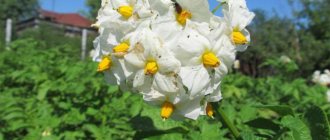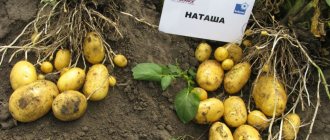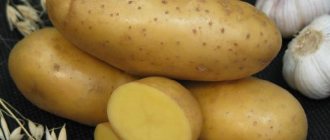In the ranking of several thousand potato varieties, Lorch , which will turn 100 years old in 3 years, occupies a leading position. The history of the birth and existence of potatoes is worthy of respect.
Potatoes owe their appearance to one of the founders of breeding in the USSR, Alexander Lorch, who during the years of Soviet power worked at the Korenevskaya experimental station in the Moscow region. Now she bears his name.
While working on the creation of a new variety, the scientist Lorch thought about how to feed a “second bread” to a huge country where there are different climatic conditions. Years of testing showed that Lorch potatoes were up to the task. The territory of its cultivation is enviable. Potatoes are equally comfortable in the center of Russia and in the North-West, the Caucasus, the lower and middle Volga, the Urals and even the Far East. In 1931, after much testing, Lorch potatoes were included in the State Register of the country.
Characteristics of Lorch potatoes
Having won the love and trust of citizens, potatoes were in great demand until the middle of the last century. And then, unable to withstand the competition, he lost ground.
Years of oblivion have not erased the former glory. The era of revival of the Lorch potato variety was the 70s of the 20th century, when compatriots remembered the plant’s environmental friendliness and beneficial qualities. Potato proteins (2%) contain almost all the necessary amino acids; the plant is rich in iron, potassium, magnesium, phosphorus, calcium, iodine, vitamins C (18%) and group B.
The Lorch potato is a mid-late variety of universal use. The growing season lasts 95-120 days. The yield is good, 1 bush bears 20-25 fruits, 250-350 centners can be collected from 1 hectare. Keeping quality is high - 88-92%.
Root vegetables are characterized by a pleasant taste, crumbly pulp that does not soften during cooking and does not darken, and a high starch content (up to 22%). In this parameter, which determines the plant’s readiness for industrial scale processing for starch, root crops have no equal.
Potato tubers have the following characteristics:
- shape – the usual round-oval;
- peel color – light beige;
- the number of eyes on the surface is not many;
- location of the eyes – they are placed evenly, do not go deep.
The pulp of root vegetables is white, does not change color during peeling, and is characterized by slight wateriness. Experts and consumers highly value the taste of Lorch root vegetables. The tubers belong to category C, their main purpose is to be used for culinary purposes. The plant is suitable for purees, frying and soups.
Potatoes "Lorch": description of the variety, photos and reviews
Do you know that:
You need to collect medicinal flowers and inflorescences at the very beginning of the flowering period, when the content of nutrients in them is highest. Flowers are supposed to be picked by hand, tearing off the rough stalks. Dry the collected flowers and herbs, scattered in a thin layer, in a cool room at natural temperature without access to direct sunlight.
In Australia, scientists have begun experiments in cloning several varieties of grapes grown in cold regions. Climate warming, which is predicted for the next 50 years, will lead to their disappearance. Australian varieties have excellent characteristics for winemaking and are not susceptible to diseases common in Europe and America.
A new product from American developers is the Tertill robot, which weeds weeds in the garden. The device was invented under the leadership of John Downes (creator of the robot vacuum cleaner) and works autonomously in all weather conditions, moving over uneven surfaces on wheels. At the same time, it cuts off all plants below 3 cm with the built-in trimmer.
Convenient Android applications have been developed to help gardeners and gardeners. First of all, these are sowing (lunar, flower, etc.) calendars, thematic magazines, and collections of useful tips. With their help, you can choose a day favorable for planting each type of plant, determine the timing of their ripening and harvest on time.
From varietal tomatoes you can get “your own” seeds for sowing next year (if you really like the variety). But it is useless to do this with hybrids: you will get seeds, but they will carry the hereditary material not of the plant from which they were taken, but of its numerous “ancestors”.
In little Denmark, any piece of land is a very expensive pleasure. Therefore, local gardeners have adapted to growing fresh vegetables in buckets, large bags, and foam boxes filled with a special earthen mixture. Such agrotechnical methods make it possible to obtain a harvest even at home.
One of the most convenient methods for preparing a harvest of vegetables, fruits and berries is freezing. Some believe that freezing causes the nutritional and health benefits of plant foods to be lost. As a result of the research, scientists have found that there is practically no decrease in nutritional value when frozen.
Humus is rotted manure or bird droppings. It is prepared like this: the manure is piled up in a heap or pile, layered with sawdust, peat and garden soil. The pile is covered with film to stabilize temperature and humidity (this is necessary to increase the activity of microorganisms). The fertilizer “ripens” within 2-5 years, depending on external conditions and the composition of the feedstock. The output is a loose, homogeneous mass with a pleasant smell of fresh earth.
It is believed that some vegetables and fruits (cucumbers, stem celery, all varieties of cabbage, peppers, apples) have “negative calorie content,” that is, more calories are consumed during digestion than they contain. In fact, only 10-20% of the calories received from food are consumed in the digestive process.
Pros and cons of the variety
Before making a decision to plant one or another potato variety on his plot, each gardener studies its strengths and weaknesses, so that in the fall he can put bags of good tubers in the cellar, and not regret the time spent.
Among the undeniable advantages:
- excellent taste;
- high and stable yield - more than 90%;
- willingness to grow in different climates;
- no special requirements for care and fertilizers;
- suitability for long-term transportation;
- ability for long-term storage;
- increased resistance to diseases and pests;
Among the disadvantages of potatoes:
- difficulty in purchasing seed;
- dependence on moisture and high temperatures;
- susceptibility to certain diseases;
- dependence of yield on cultivation methods.
Reviews about the variety
On the Internet you can find a huge number of positive reviews about the Lorch variety. Many gardeners note its versatility, high productivity, and low maintenance requirements.
★★★★★
Oksana, 47 years old, housewife. We have a large vegetable garden not far from our house, so we decided to plant new seeds.
My husband and I visited a specialized store, where we were offered the Lorch variety. The seeds did not exceed 5 cm in diameter. The length of each tuber reached up to 15 cm. We noticed that the roots did not spread anywhere, digging potatoes was not difficult - all the fruits lay in a heap in the hole. The potatoes have white flesh and excellent taste – the whole family appreciated them. They prepared it in different ways: boiled, fried and baked - superb. From two acres we received 6 bags of potatoes. The main thing I liked about this variety is its minimal care requirements. Potatoes grow on their own. ★★★★★
Marina, 30 years old, lives in her own house. Gardener friends recommended the Lorch variety.
For myself, I highlighted several pleasant moments: the bush produces a lot of fruit, sometimes even up to 20 large potatoes. There are very few seed potatoes, so I often cut a large root vegetable into several pieces for seeds and germinate them. I like both the smell of potatoes and their appearance, although I prefer the yellow varieties. The family loves Lorch's mashed potatoes. ★★★★★
Konstantin, 54 years old, gardener. This is not the first year I have been using Lorch potatoes for planting.
Always born well. The tubers are large and identical. Unfortunately, my potatoes very often suffer from late blight, so I have to regularly monitor the condition of the plants and treat them. But I am amazed by the high yield, external qualities and pleasant taste and aroma when cooked. When people ask me what kind of potatoes I grow, I recommend only this variety, because among many that I have tried, this is the best. Hide
Add your review
Lorch potatoes are considered one of the popular varieties today. It is preferred due to its high yield, excellent appearance and good taste. But in many ways, the yield and appearance of the fruit depends on proper care. The main thing is to follow the rules of planting, growing and caring for the plant.
0
0
Copy link
Landing Features
Before choosing a planting site, it is worth assessing the capabilities of the site. Despite all its unpretentiousness, the plant reacts to a lack of light. If it is not enough, it will direct its strength to the tops, and not to the roots.
It is important to consider what varieties of crops grew on the site before potatoes. Sunflowers, tomatoes and sorghum are carriers of infections and viruses. They are not suitable as predecessors.
Carrots, cucumbers, pumpkins, beets, strawberries, which give some of the nutrients to the earth, are considered an ideal choice. And if they are cereals, they are called soil health workers, the potatoes will reward you with high-quality tubers.
The planting area must be level. Preparatory work begins in the fall, when the soil is dug up and organic fertilizers are applied. Manure is scattered over the surface and mixed with soil during the digging process. In the spring, the digging procedure is repeated. At this time, the beds are fertilized with fertilizers containing nitrogen.
They plant potatoes in early May, but in general they adhere to two indicators, one of which belongs to the scientific category, the second to the category of folk signs. The soil receiving the tubers should warm up to +6 +8 ℃ at a depth of 10 cm, and the birch tree should bloom its leaves.
Lorch potatoes are unpretentious to the soil, but every farmer or gardener thinking about the future harvest will choose cultivated soil - sandstone or loam. On heavier soils, the plant will produce small and deformed tubers, and if it rains heavily, it may become completely sick and die.
Before planting, you need to consider some features of potatoes:
- The tubers are planted in the ground whole, eyes down. If you cut them, you won’t have to expect a good harvest;
- the variety is suitable for planting without germination, but in this case, Lorch potatoes can be dug up 2-3 weeks later than usual;
- soil with close groundwater is not the best option for vegetables. The situation will be corrected by raising the beds to a height of 15-20 cm, this is done before planting.
When starting planting, you should take into account the height of the bushes. The distance between the holes should be at least 35-40 cm, between the beds 70-80 cm. Otherwise, the plant, which is distinguished not only by its height, but also by its spreading nature, will react poorly to cramped conditions.
Lorch potatoes are placed in holes prepared in advance and deepened:
- large root vegetables 8-10 cm;
- small tubers 6-8 cm.
If planting is carried out according to all the rules, after 6 days the Lorch potatoes will sprout, and after 110-120 days you can enjoy the baked tubers.
Peculiarities
Due to his age, Lorch has taken root well not only in most regions of the Russian Federation, but also in all neighboring countries. And its taste and beautiful appearance of the fruit have ensured it more than one decade of successful sales in many European markets. In addition, do not forget that it is also used for industrial purposes to produce starch.
IMPORTANT! As for choosing an area for planting, it is necessary to highlight the following: young crops of this potato crop do not like too much heat and lack of moisture in the soil. Therefore, gardeners from the southern regions should prepare good watering conditions, preferably automated.
In terms of soil selection, this variety is not too picky, however,
if there is a lack of potassium and phosphorus in the soil, the resulting fruits may have a less attractive appearance.
Some gardeners also prefer to cut their planting material to increase its quantity. And while some varieties can survive this procedure with minimal losses, in the case of Lorch, the quality and volume of the harvest will be significantly reduced. Your sprouted tubers should be planted in holes about 8 cm deep. Unlike many other types of potatoes, Lorch tubers should be placed with the sprouts facing down. This stimulates the formation of more spreading bushes, which, accordingly, will have better lighting. Subsequently, your plants need to be provided with mandatory fertilizing; nitrogen fertilizers are best suited here, which can be applied already at the growing season.
Read more about how to feed potatoes, what fertilizers are the best and why experts recommend the use of mineral fertilizers. And also when and how to fertilize, how to do it correctly when planting.
In general, standard agrotechnical techniques are used when growing this variety - hilling, weed control, mulching if necessary and desired, watering.
If you are not sure whether potatoes need hilling, you will find the answer to this question in the article on our website. You will also find out what devices can be used for hilling, how manual hilling differs from mechanized hilling, and whether it is possible to get a good harvest without weeding and hilling.
Care
Caring for this vegetable crop is not much different from others, but there are still some nuances. Considering that Lorch potatoes do not like high temperatures and require moisture, you need to keep an eye on this. If the process is left to chance, there will be no normally developed tubers. You need to water the potatoes:
- immediately after landing;
- after emergence;
- before starting to set buds;
- at the height of flowering;
- after flowering is complete.
Each potato bush requires at least 3-4 liters of liquid. If the summer turns out to be dry, during the growing season it is necessary to water the plant once every 10 days. The vegetable responds well to loosening and mulching.
Loosening
Experienced gardeners carry out loosening immediately after rain or watering.
Target:
- remove heavy earthen crust along with weeds that absorb nutrients;
- open access of oxygen to the roots.
Mulching
Mulching Lorch potatoes, for which dry grass is used, is recommended to be carried out after watering and loosening.
Target:
- keep the soil moist;
- do not let the weeds run rampant.
Hilling
We must not forget about hilling. This procedure not only opens access to oxygen and moisture to the roots, it protects fragile seedlings from possible cold weather. During the growing season, hilling is carried out twice:
- the first time when the tops stretch 15 cm;
- the second time - after 15-20 days.
A long growing season requires a special regime in feeding with nutrients. Working on the creation of a hybrid, which Alexander Lorch developed by crossing the Svityaz and Smyslovsky varieties, Lorch focused on organic fertilizers, forcing each employee of the experimental station to bring at least 1 bucket of wood ash. He considered it the best type of fertilizer.
Summer residents, following the instructions of the creator, add 20 g of ash under the bush. Among other types of organic matter, it is worth paying attention to manure and humus.
During the growing season, potato tubers need phosphorus and potassium. If these microelements are not enough, the root vegetables will not grow round-oval, but elongated.
How to save energy when growing potatoes
There are many secrets, knowledge of which can save effort and time when working in the garden. For example, it is often recommended to prepare the soil for planting potatoes by digging it with a spade. But there is another way in which the soil is prepared using a hoe. And this is a less labor-intensive method that saves the gardener’s energy.
When planting material, it is recommended to place the tubers with their eyes down - this will allow the bush to grow more spreading and strong. The distance between the rows should be 70–80 cm and should not be reduced, as this will result in poor lighting and a risk of late blight. It is best to orient the beds from north to south - this will help to receive a sufficient amount of light.
The depth of embedding in the soil depends on its severity: on loam, the optimal distance is 5–6 cm, on sandy loam - 8–10 cm. The mid-late Lorch variety is recommended to be planted at intervals of at least 30–35 cm. After the planting material is laid out in the furrow, it is covered with humus. To provide the future potato bush with adequate nutrition, it must cover the tubers. After this, the furrow is covered with earth.
Video: a simple, fast and reliable way to plant potatoes
However, if we are talking about the southern regions, then this method is not suitable. In this case, it is necessary to dig up the soil in the fall - this way the soil will accumulate more moisture, which is especially important when growing potatoes in hot climates.
Plantings respond very well to loosening the soil: this way the roots are better provided with oxygen. The soil should not be very wet, but not dry either. As soon as the surface of the soil forms a crust, it is necessary to loosen the soil using a tool that will not damage the plant.
A technique such as hilling is especially recommended for the northern regions of Russia and the middle zone. The optimal time for hilling is evening or early morning, but never the middle of a hot day. Be sure to water the potatoes before doing this. The first hilling is carried out at a bush height of 13–15 cm and after 20 days the procedure is repeated.
Watering potatoes
The frequency of watering potatoes depends on the growing region: in the southern regions, the crop will not grow without additional moisture, and in a temperate climate with frequent rains, you can sometimes forget about watering. An indicator that the plantings need additional moisture is the condition of the tops: in this case, they will wither. Water consumption when irrigation is approximately 50 liters per 1 m2, the soil should be spilled to a depth of at least 45 cm.
The first watering is carried out after the emergence of seedlings. Since during the flowering period potatoes need liquid more than at any other time, it is necessary to water them at the stage of the appearance of the first buds. And the potatoes are watered a third time after flowering.
A month after the potatoes are planted, it is advisable to fertilize them. Per 1 m2, take 10 g of urea and sulfate, add 20 g of superphosphate and dilute the resulting composition in water for irrigation. The second feeding is necessary during the appearance of buds and the third time - after the end of flowering. Lorch reacts very well to bird droppings in a ratio of 200 g per 1 m2.
Table: ways to combat potato diseases Lorch
| Disease | Fighting method |
| Late blight | A Bordeaux mixture of 1% concentration is recommended. For 1 m2 you will need 4 liters of solution. Treatments are carried out once a week - ten days. Frequency of treatments - no more than 4 |
| Nematode | The use of biological preparations such as Nemabact makes it possible to displace nematodes from infected areas |
| Potato cancer | Treatment of seed material with a 1% suspension of foundationazole or a 0.5% suspension of benomyl (benleit) |
| Common scab | Treatment of seed material with Fungazil 100 SL, Rovral, Aquaflo or Maxim 025 FS |
The yield of the Lorch variety is good, but there is a way to make this figure even higher. To conserve the strength of mid-late ripening potatoes, it is recommended to pick the nascent buds from the bush. The fact is that potatoes spend a lot of energy on flowering, seed formation and their further ripening. If you do not give it the opportunity to bloom, then all the energy is naturally spent on vegetative reproduction - on the development of tubers. Therefore, if the goal is not to obtain seed material from a potato bush, then it is better to remove the buds.
Timely removal of flowers from the bush saves the plant’s energy for the formation of tubers
To prevent the development of late blight, it is recommended not to allow the tops of neighboring bushes to overlap. Once the foliage has grown sufficiently, it needs to be thinned out. When the foliage begins to dry out and turn yellow, this is a signal that the root crop has already received everything it needs from the tops and you can mow it, leaving stems about 10 cm long. But you definitely need to dig up the bush and check the condition of the potatoes - if the skin of the tubers is strong and dense, then the tops are already can be mowed. To prevent the spread of late blight, the foliage must be burned and should never be used for compost.
An indicator of the appropriate time to mow the tops is the condition of the tubers
Harvesting the Lorch potato variety must be done before the first frost, on a dry and sunny day. Keeping quality directly depends on this: at low temperatures at the time of collection, this indicator decreases. It is undesirable for the tubers to be overripe, since during storage they are susceptible to diseases and partially lose their taste.
Harvesting and storage
Harvesting usually begins at the end of August or beginning of September. The starting signal is:
- dried tops that lie on the ground;
- thick skin on potatoes.
Work should begin by mowing the foliage, leaving shoots up to 10 cm in height above the ground. It is customary to dig up the crop with a pitchfork, moving along the rows.
The dug up potatoes must be dried on the spot. After a few hours, it is cleared of soil and placed in bags or boxes, discarding questionable tubers.
During storage, you need to monitor the room ventilation and temperature. The norm is 2-4 ℃, humidity is no more than 83-85%. From time to time, Lorch potatoes need to be sorted to avoid rot.
Description and characteristics of the plant and crop
Lorch bushes are tall, with erect or semi-erect stems . Stems and leaves are pale green. Leaves are produced in large numbers. The flowers are purple-pink in color.
The tubers are light beige in color, with a thin, strong skin , smooth, oblong in shape, with slight peeling near the top of the tuber. Each bush produces up to 16 potatoes, approximately 120 g each. The eyes are practically absent and are located shallowly and evenly. The pulp is not watery, soft.
Productivity
Many vegetable growers speak of this variety as high-yielding . Since their appearance, potatoes have not lost their leading positions in taste and yield. The crop is unpretentious and can be grown on any soil; it tolerates frost and drought well. From one bush of the Lorch variety you can collect up to 2 kg of tubers.
Diseases and parasites
Lorch potatoes are protected from diseases by their genetics and immunity. But still, scab and nematode are destructive for him.
There are practically no methods for combating root scab of this plant variety, so the emphasis is on prevention. It is worth remembering a few rules:
- it is necessary to observe crop rotation;
- Potatoes can be planted in the same place only after 2-3 years;
- water the bushes on time.
Tubers affected by cancer should not be eaten. If a disease is detected, the potatoes are completely removed from the ground, and then buried again to a depth of 1 meter and the soil must be treated with bleach.
It is not recommended to grow in this area for 7 years. Prevention of the disease will be the treatment of seed material with a solution of boric acid and careful selection of tubers before planting.
To avoid late blight of root crops, which can happen in rainy summers, it is necessary to thin out potato bushes from time to time. Colorado potato beetles pose a danger to the plant. If there are few of them, insects are collected by hand. If this measure is not enough, treat the potato bushes with special insecticides.
Advantages and disadvantages of the variety
It’s not for nothing that the Lorch potato has retained its leadership for more than 80 years - all thanks to a number of advantages:
- high yield - fruiting does not depend on weather conditions;
- frost resistance - if one sprout freezes, the plant replaces it with another;
- tubers are approximately the same size, which facilitates mechanized harvesting;
- excellent taste with optimal starch content;
- good adaptability to soil;
- keeping quality and transportability.
Minuses:
- poor tolerance to too wet soil;
- average resistance to infections.
Which regions is best suited for?
At the moment, Lorch is officially approved for cultivation in the following regions :
- Northwestern;
- Central;
- Central Black Earth;
- North Caucasian;
- Middle Volga;
- Ural;
- Nizhnevolzhsky.
Reviews
“My grandfather, an avid gardener, once spoke about Lorch potatoes. Having seen an advertisement for the sale of planting material, we got into the car, and after a couple of weeks we were planting plant tubers on the plot.” - Unknown source.
All agricultural technology was followed. The Lorch root crops were harvested on time. There were no big troubles during the growth process. We fry, stew, cook – we consider the puree from this variety to be the best. We recommend it to everyone,” - Losev family, town. Maksatikha.
“I can’t call the Lorch potato variety unpretentious. Lorch potatoes are very tasty, but they also require a lot of attention. I grew it for the first time and suffered with late blight. This year I will experiment again, and then I will draw a conclusion whether this variety is worth such efforts or return to more modern species that are adapted to current conditions,” Elena Nilova, Belgorod region.
Features of cultivation
Features of growing Lorch potatoes include maintaining soil moisture and timely harvesting. Otherwise, the culture is similar to general agricultural technology, in which hilling and fertilizing are used as needed.
Watering schedule
The characteristics and reviews of the Lorch potato variety describe its demands on soil moisture. Regular and even watering begins from the moment the sprouts emerge. Watering before the appearance of the vegetative mass leads to the superficial occurrence of tubers. Uniform soil moisture during the period of bud formation is especially important.
Important! Lack of moisture during the flowering period leads to low tuber set, which cannot be compensated for by further watering.
Sudden changes in watering cause defects in the shape of tubers. Sprinkling and installing drip structures are considered good ways to water potatoes.
Loosening, weeding, hilling
Successful cultivation requires timely weeding, loosening and hilling.
During the period from planting to the release of the vegetative mass, weeding helps get rid of weeds that take away nutrition and moisture. Therefore, weed removal begins from the first week of cultivation, combining weeding with loosening.
The soil is also loosened after watering or rain, which is important for tuber respiration and rapid plant growth. It is necessary to loosen not only the soil around the planting, but also the space between the rows.
Hilling is carried out several times a season, which allows you to protect the crop from possible return frosts at the end of spring, and subsequently increase the number of tubers under the potato bush.
Advice! It is best to hill potatoes after watering or rain.
The first addition is carried out when the vegetative mass reaches a height of about 15 cm. The soil from the rows is raked from opposite sides to the bush, creating a small mound at the base of the plant. The second hilling is carried out before flowering begins, and subsequent hillings are carried out if necessary, if the soil has crumbled or the tubers are exposed.
Do I need to feed
Additional fertilizing is applied to potatoes in case of growth retardation and poor development. Microelements such as boron and copper are especially important for culture. Use nitrogen fertilizers with caution and do not use compounds with chlorine.
It is best to use organic fertilizers in liquid form, for example, herbal infusions.
Potato diseases and pests
Lorch potatoes have strong immunity and resistance to viral bacteriosis, late blight, verticillium, and viral diseases.
Did you know? Despite the fact that potatoes are grown everywhere in European countries today and are an indispensable product in the kitchens of many European countries, their homeland is Central America, from where they were brought at the end of the 16th century. The root vegetable was brought to Russia by Peter I, who wanted to feed the entire Russian people with a simple vegetable.
Often, due to non-compliance with basic growing rules, a vegetable is subject to:
- Common scab . Small light brown ulcers or thickenings similar to warts form on the surface of the tubers, the taste of the fruit deteriorates and their presentation decreases. During a season, scab can destroy more than half of the entire crop. Unfortunately, there are no cures for scab. To prevent its development, preventive measures should be carried out in a timely manner.
- Potato cancer . The disease affects root crops, as a result of which growths grow on the surface from the eyes, similar in appearance to cauliflower inflorescences. At the initial stage, the growths are light yellow in color, then they become brown and begin to rot. It is not recommended to eat tubers affected by cancer. To combat the disease, infected bushes are completely destroyed and the soil is sprinkled with lime. It is allowed to re-grow potatoes in this area only after 7 years.
In addition to diseases, Lorch potatoes can become “prey” for some parasites.
In particular:
- Colorado potato beetle . The pest eats tubers, foliage, and stems, as a result of which the plant becomes depleted and stops its development. In the fight against the beetle, which can adapt to all climatic conditions, modern special preparations, for example, “Aktara” or “Prestige” or effective folk remedies - tar, urea, dill, as well as collecting larvae and beetles by hand, will help.
- Medvedki . The parasite infects the stem of the plant, ruptures the root system, eats the tubers, and as a result, the bush dies and the root crops become unsuitable for consumption. It is customary to fight the mole cricket and its larvae using special means - “Medvetox”, “Grizzly”, “Thunder”, which are scattered into the depressions formed between the rows of potatoes.
Productivity and advantages of the Lorch variety
The potato variety does not have high yields. On average, 3 kilograms of potatoes are harvested from 1 square meter. One bush can produce up to 25 tubers. To maintain average yields, it is necessary to maintain the soil water balance.
The advantages include:
- taste;
- adaptability to growing in different climatic conditions;
- stable yield of the variety;
- high degree of transportability and storage;
- disease resistance;
- not picky about care.
Potatoes were bred during times of food shortages, so the plant has quite a few disadvantages, for example, the risk of plant diseases. Failure to follow growing instructions may result in problems with the harvest. The root system is susceptible to destruction due to lack of moisture or exposure to high temperatures.
Selection and preparation of planting material
When purchasing seeds in a store, you should only remove root crops that have external signs of disease or deformation. Healthy planting material will give a rich harvest.
When independently selecting Lorch potato seeds, choose apparently healthy tubers that are not damaged by tools. This is done immediately after harvesting.
In order for the crop to sprout earlier, summer residents advise germinating root crops. To do this, the tubers are taken out of storage a month in advance. Wash and soak in manganese solution for 30 minutes. Then lay out in one layer in a bright, well-ventilated area. The temperature in it is +10-12 ⁰С.
During the entire germination period, the potatoes are carefully inspected. Select all suspicious tubers, periodically sprinkling them with water and turning them over. The length of the sprouts before planting should be at least 1 cm.
Pest and disease control
Lorch potatoes are vulnerable to scab and potato blight. To prevent diseases, follow the rules of agricultural technology:
- alternate planting crops on the site, returning potatoes to their original beds no earlier than after 4-5 years;
- if it is impossible to change the site, green manure (oats, mustard, lupine) is sown in the fall to improve soil health;
- Only high-quality potatoes are selected for seed material;
- purchase tubers from trusted suppliers with a mandatory product certificate;
- Tubers are treated with fungicides and biological products before planting.
Lorch tubers are often infested by wireworms. To destroy the pest, insecticides are used (Thunder, Aktara, Grizzly), observing the processing time and taking into account the time of harvest.
Regularly clear the beds of weeds (especially sow thistle and wheatgrass), mow the grass at the edges, and sow calendula and tagetes (marigolds) around the perimeter of the potato plantations to repel pests. It is recommended to renew the seed material in advance and sort potatoes during storage, pre-treating them in protective compounds.
Planting potatoes
Manifest potatoes begin to be planted only after the soil temperature at a depth of 10 cm is at least +8 °C. Planting planting material in colder soil very often provokes damage to potato sprouts by a disease such as rhizoctonia. However, delaying potato planting for a week causes a crop shortfall of approximately 7-8%.
When planting prepared planting material, potato tubers should be placed with the most uniform depth, which has a beneficial effect on the uniformity of seedlings. It is necessary to leave loose soil under the planted tubers. Optimal lighting performance is achieved by placing potato bushes at the same distance.
